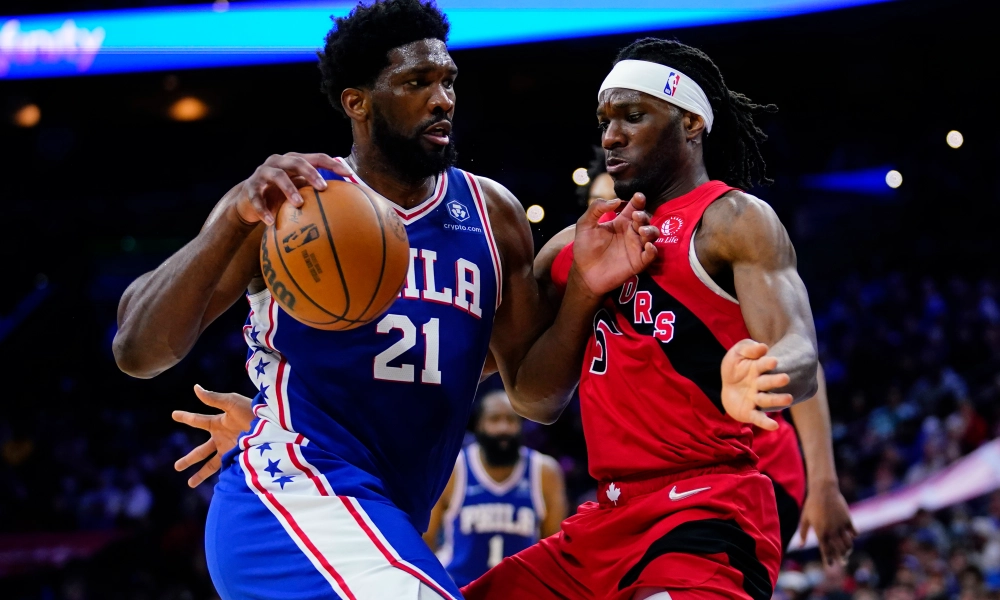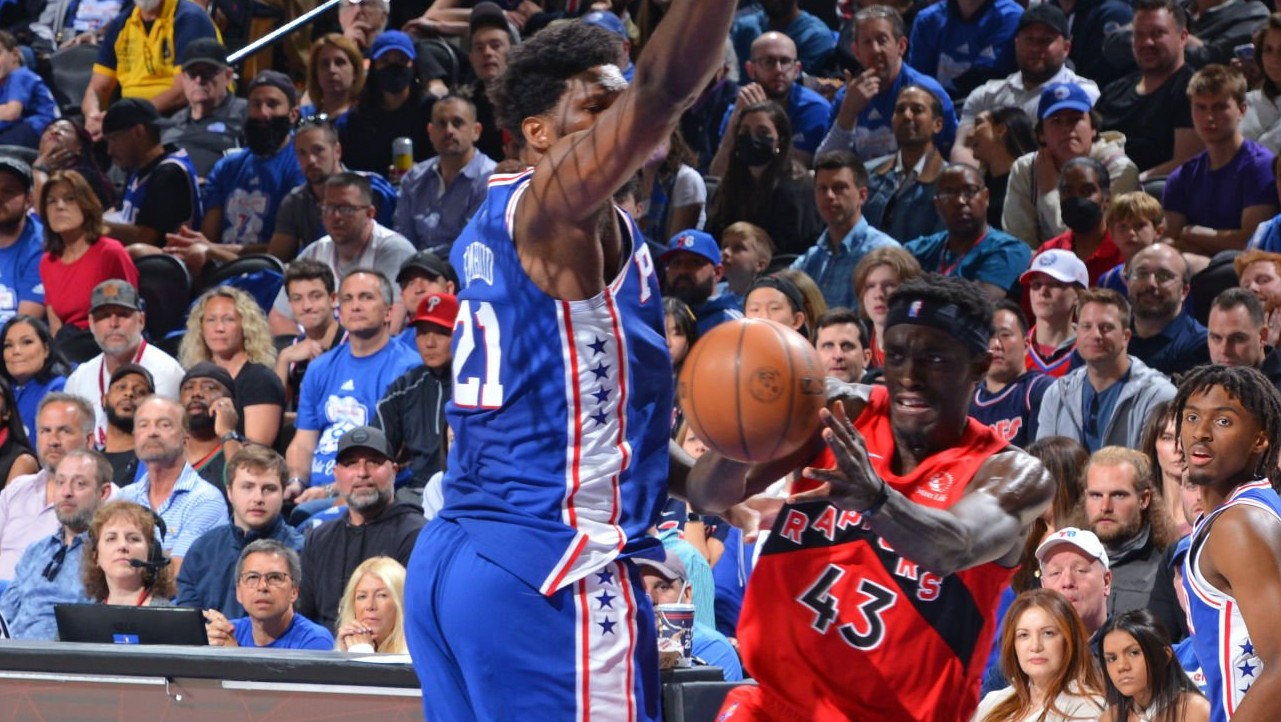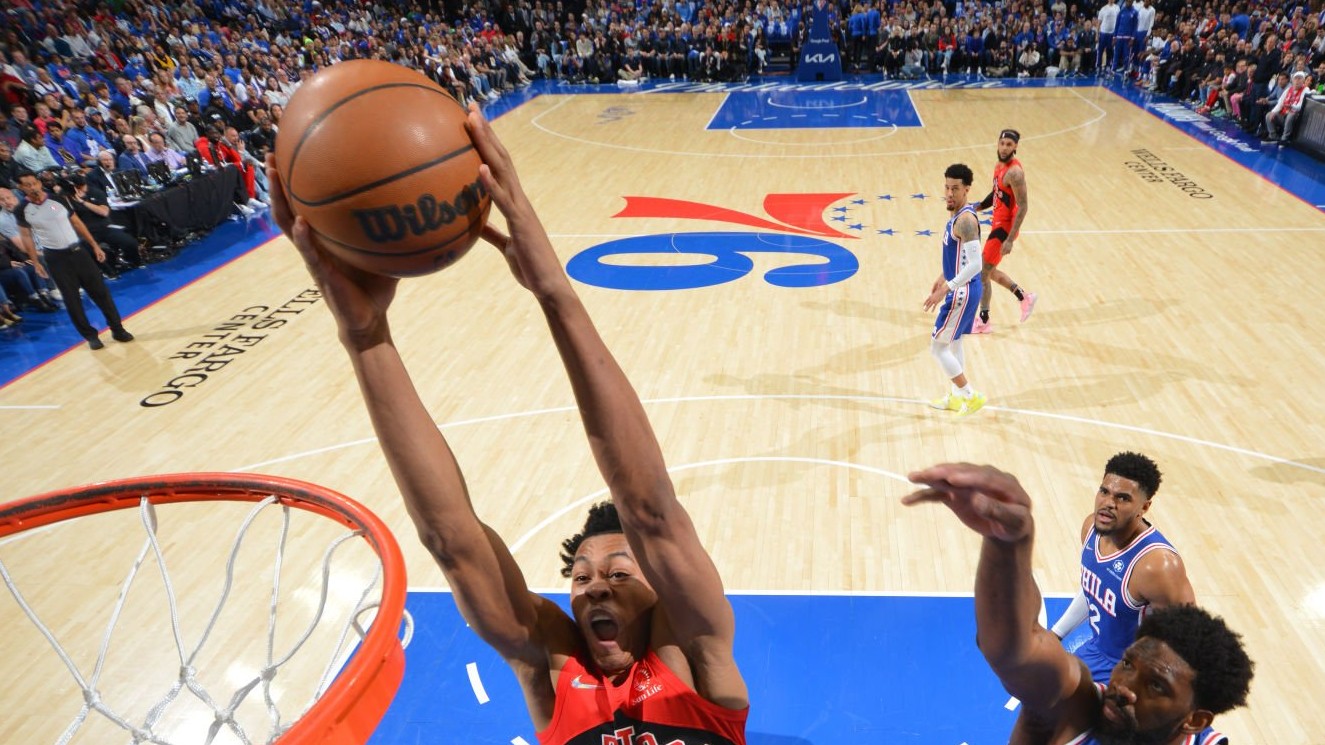Smoke mists and hazes off the sidewalk in gouts. The air smells clean in the early morning. But look closer: there’s something on the ground. Your stomach lurches. It can’t be. You look closer, trying to wave away the mist, but it refills instantly in the space you clear. You stop trying. It is. There’s a body. It’s the Toronto Raptors.
You sigh and roll a cigarette. Your hand doesn’t shake. You might take a moment to wonder at that, to grunt at your scar tissue cauterizing your nerves, your inability to react to such carnage. But then again, you might not take that time — you’ve seen it all before, after all. This isn’t the first body you’ve seen, and it won’t be the last. If you’re lucky, that is: Without this, what would you have? No, don’t think about that. You take out your notebook. When you finish smoking, the wisps from your cigarette blending with the cool morning mist and drifting into nowhere, you shake your head. Maybe it does affect you after all. But you have a job to do, and you can’t spend time thinking about that, either. You walk to the body and lean over it. Time to solve the crime: What killed the Toronto Raptors?
It’s hard to make out individual injuries, at first. The body is such an interlocked tangle of wounds, some dried, some fresh. Hard to distinguish. But slowly they start to take shape, the story told in blood like a cave painting.
The first thing you see, chosen randomly from the twisted wellspring of violence, is Gary Trent jr. missing his first seven shots of the game, almost all open, the last of which was an uncontested, flat-footed layup — after he missed, he threw himself on the ground in trying to draw free throws. He can’t be blamed there. Whenever the Philadelphia 76ers were in a tight spot, they always seemed to be able to grift their way to easy points at the line. Joel Embiid especially, for being perhaps the largest man in the NBA, fell over at the slightest hint of contact. But no, you see, no: the free throws weren’t a fatal blow, not even close. Those wounds were post-mortem. The Raptors had so little defensive pressure throughout the game, so poorly applied, that the Sixers could have lost all their points gained from the line, and it still would have been a close-run thing.
Well, to be fair, Fred VanVleet and Chris Boucher did foul out of the game, and many of their fouls were, shall we say, unearned. The Raptors’ defense never had a chance to get in rhythm. But the extent of the mangling is so monstrous that exterior factors are certainly not enough to explain this crime. Not by a long shot.
That goriest injury, Toronto’s poor defense, carves the poor body from stern to bow. The Raptors let Joel Embiid get deep post position at will and showed him either too many bodies too early — opening up easy lanes for passes — or too few bodies too late, giving him the easiest playoff baskets he’s had in his career. Little hooks, layups, jumpers: The cuts and slashes are stamped across the body’s torso, pain in miniature. James Harden hit stepback threes with almost no defensive attention; it was clear that Toronto’s defensive playbook was to lay off of him on the stepback, too afraid of gifting the man free throws, but the result of that strategy is written on the cold stone outlined in chalk.
And with Toronto’s attention focused on Embiid and Harden (who still dismantled the Raptors), the other Sixers were left free to attack rotations at the point of attack and in the paint. Tobias Harris scored 26 on 14 shots, drilling jumpers and runners and fadeaways and putbacks on the offensive glass. Again: Surface wounds. Glancing blows. The true killer was Tyrese Maxey. He scored 38 points, drilling stepback jumpers, catch-and-shoot jumpers, driving through the heart of Toronto’s excuse for a defensive shell for layups, both soaring ones over help and uncontested ones while Toronto’s defenders gestured at one another in exasperation.
“He got some really naked looks,” said Nick Nurse of Maxey after the game.
Toronto’s gameplan was supposed to take two players out of the game, and neither felt much pressure, was hurried or rushed. Sure, they shot inefficiently, but they passed exceptionally and committed no turnovers. (Harden, to my eyes certainly committed at least two, but the scorekeepers alas ruled the plays blocked shots.) And in exchange for Toronto’s efforts, the tertiary guys were allowed to run wild.
And yet you can’t help but feel like you haven’t found the true cause of death yet. You found the killer but not the cause. Everything else, no matter how gory, feels trivial in comparison. There’s something deeper. You plug your nose, for spending so long with this body is starting to take its toll on your senses, and dive deeper into the autopsy.
The cause of death is right in front of you, under your nose, so obvious when you see it that all else pales in comparison, no matter the seeming extent of damage. The numbers are in front of you: 3. 7. Small, inconsequential at first, but their meaning is overwhelming. The Philadelphia 76ers committed three turnovers in their bludgeoning of their hapless foe, the tied-fewest in the history of the playoffs. The Raptors grabbed six meager offensive rebounds.
Toronto’s entire identity as a basketball squad is in creating more possessions than their opponent. Philadelphia is more efficient than Toronto in virtually every area of the court: isolation, the post, pick and roll, catch and shoot, pulling up, in transition. The only hope the Raptors have is to scrounge more shots than their opponent. Instead, they forced the fewest turnovers in the history of playoff basketball and grabbed their fewest offensive rebounds of the season. There it is. The fatal blow. Everything else was painful, sure, but ultimately survivable.
“A lot of what we do is predicated on our aggressiveness and our length and making plays on the ball, causing turnovers, blocking shots,” said VanVleet after the game. “And I think whether that was jitters from some of the newer guys or the whistle or whatever the case may be, we were just a little slow. They were more physical, they won the physicality battle. And you could argue about officiating all day, but there’s still ways to be physical without fouling. They won that battle tonight.”
The Raptors, of course, because it’s game one, and because of Murphy’s Law, were mangled after death. Thad Young sprained his thumb. Scottie Barnes sprained his ankle, and it looked bad. Barnes was in the midst of one of the greatest rookie playoff performances in Raptors’ history before his injury. Actually, one of the greatest first-playoff-games-for-a-rookie performances in history; Barnes is now one of two players to have scored 15 or more points, grabbed 10 or more rebounds, and thrown eight or more assists in his first career playoff game. (Todd Lichti, before you try to guess, is the other.) More on Barnes later today from the inimitable Samson Folk. Nurse said after the game that X-rays on both players were negative, though there will be further imaging today. Perhaps they’ll be available to return after all. If not, the loss of Barnes especially would be catastrophic, far worse than the loss of a single game. Sometimes the damage done after death is far worse than a passing on its own.
There was more, of course. So much more. Your head is spinning, and you don’t think you can stand further investigations. You stop taking detailed notes and switch to point form, the most you can handle. The sun is starting to rise, burning off the mist, and you can see the body more clearly than ever before. You hurry in your work.
- The Raptors lost the Embiid-on-the-bench minutes by four points. Catastrophe. If the Raps are going to win the series, they have to win those minutes. Same as how they beat Philly in 2019.
- Toronto’s no-center starting minutes lost by seven in the first quarter and two in the third. The defense was not connected, and the offense was not sharp. Which has been the case all year! Toronto’s regular starting group of VanVleet, Trent, Anunoby, Siakam, and Barnes had a negative net rating on the year. It might be time to change the starting lineup to begin the next game.
- Precious Achiuwa, like Trent, was rushed on offense. He settled in later and even hit a pair of threes; his final numbers looked pretty good! But he was pressing early. Normal for young players. Achiuwa, unlike Trent, turned it around.
- Toronto shot 40 percent from three! Not so bad, but when you consider that they outshot their expectations, and still lost by 20, it means more shooting probably can’t be expected to help turn the edges in Toronto’s favour. (That the Sixers shot 50 percent from three also hurts.)
- Maxey stayed in the game after both teams emptied their benches, trying to reach the 40-point threshold. Toronto has had a long history of opponents taking them lightly in the playoffs, most of which include LeBron James. Tough reminder.
You sigh again and look away. The crime wasn’t hard to solve. It never is. There’s a long line of killers you’ve busted before — Allen Iverson, LeBron James, DJ Augustin. Tyrese Maxey isn’t special. He isn’t even original. Just the last in a long line of psychopaths. You put your notebook back in your pocket, now filled with scrawls like hieroglyphs. You look down again and see that the chalk outline isn’t correct, that an arm has twitched here, a leg there. Toronto isn’t dead. Not yet. It starts stirring, slowly at first, then faster, until it stands, chest heaving, clothes torn. You look the poor bastard up and down. It’s seen this moment before. You know you’ll be back here, solving the same crime, before too long. Hopefully not too soon, though. You watch Toronto slowly totter away. It might be energized by the beating. It might be a dead man walking. You can’t quite tell. It’s out of sight now, and you realize your hands are shaking. You can’t quite get used to this after all, no matter your hardened exterior. You think of the corpse that you just autopsied. You hope it knows what it’s doing.



